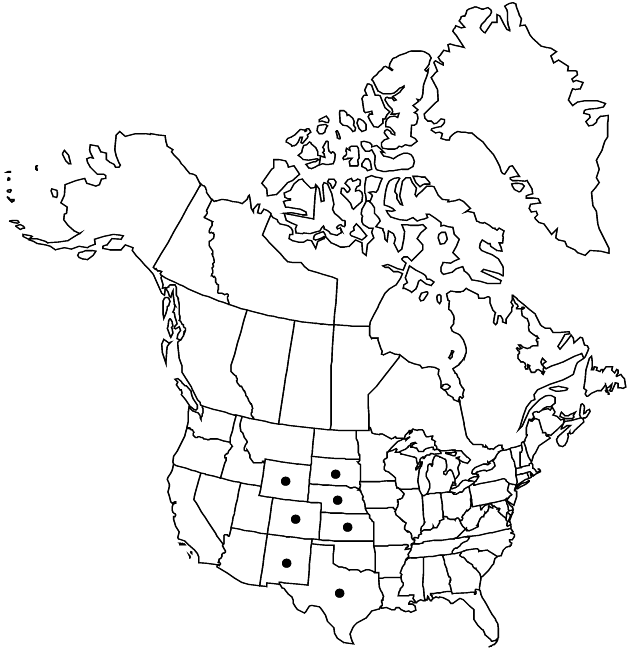Difference between revisions of "Liatris lancifolia"
in I. Tidestrom and T. Kittell, Fl. Ariz. New Mex., 370. 1941.
FNA>Volume Importer |
imported>Volume Importer |
||
| (3 intermediate revisions by 2 users not shown) | |||
| Line 1: | Line 1: | ||
{{Treatment/ID | {{Treatment/ID | ||
|accepted_name=Liatris lancifolia | |accepted_name=Liatris lancifolia | ||
| − | |accepted_authority=(Greene) | + | |accepted_authority=(Greene) Kittell |
|publications={{Treatment/Publication | |publications={{Treatment/Publication | ||
|title=in I. Tidestrom and T. Kittell, Fl. Ariz. New Mex., | |title=in I. Tidestrom and T. Kittell, Fl. Ariz. New Mex., | ||
| Line 8: | Line 8: | ||
}} | }} | ||
|common_names=Great Plains gayfeather | |common_names=Great Plains gayfeather | ||
| + | |special_status={{Treatment/ID/Special_status | ||
| + | |code=E | ||
| + | |label=Endemic | ||
| + | }} | ||
|basionyms={{Treatment/ID/Basionym | |basionyms={{Treatment/ID/Basionym | ||
|name=Lacinaria lancifolia | |name=Lacinaria lancifolia | ||
|authority=Greene | |authority=Greene | ||
| + | |rank=species | ||
|publication_title=Bull. Torrey Bot. Club | |publication_title=Bull. Torrey Bot. Club | ||
|publication_place=25: 118. 1898 | |publication_place=25: 118. 1898 | ||
| Line 17: | Line 22: | ||
|name=Liatris kansana | |name=Liatris kansana | ||
|authority=(Britton) Rydberg | |authority=(Britton) Rydberg | ||
| + | |rank=species | ||
}} | }} | ||
|hierarchy=Asteraceae;Asteraceae tribe Eupatorieae;Liatris;Liatris lancifolia | |hierarchy=Asteraceae;Asteraceae tribe Eupatorieae;Liatris;Liatris lancifolia | ||
| Line 41: | Line 47: | ||
-->{{#Taxon: | -->{{#Taxon: | ||
name=Liatris lancifolia | name=Liatris lancifolia | ||
| − | + | |authority=(Greene) Kittell | |
| − | |authority=(Greene) | ||
|rank=species | |rank=species | ||
|parent rank=genus | |parent rank=genus | ||
| Line 55: | Line 60: | ||
|publication title=in I. Tidestrom and T. Kittell, Fl. Ariz. New Mex., | |publication title=in I. Tidestrom and T. Kittell, Fl. Ariz. New Mex., | ||
|publication year=1941 | |publication year=1941 | ||
| − | |special status= | + | |special status=Endemic |
| − | |source xml=https:// | + | |source xml=https://bitbucket.org/aafc-mbb/fna-data-curation/src/2e0870ddd59836b60bcf96646a41e87ea5a5943a/coarse_grained_fna_xml/V19-20-21/V21_1325.xml |
|tribe=Asteraceae tribe Eupatorieae | |tribe=Asteraceae tribe Eupatorieae | ||
|genus=Liatris | |genus=Liatris | ||
Latest revision as of 20:09, 5 November 2020
Plants (20–)40–80 cm. Corms globose. Stems glabrous. Leaves: basal and lower cauline 3–5-nerved, narrowly oblong-lanceolate to narrowly spatulate-oblanceolate, 60–180(–330) × 6–12(–15) mm (usually becoming more densely arranged distally), abruptly reduced near midstem (continuing densely to immediately proximal to heads), essentially glabrous, gland-dotted (bases of basal often fibrous-persistent). Heads in dense, spiciform arrays. Peduncles 0. Involucres turbinate-cylindric to turbinate-campanulate, 7–9 × 4–7 mm. Phyllaries in 3–4 series, ovate to oblong, unequal, glabrous, margins with hyaline borders, sometimes ciliolate, apices rounded to obtuse. Florets 5–8(–12); corolla tubes glabrous inside. Cypselae 4–4.5 mm; pappi: lengths ± equaling corollas, bristles barbellate. 2n = 20.
Phenology: Flowering Jul–Sep.
Habitat: Prairies (often wet or moist), banks of spring-fed streams, sandy and sandy-clay soils, saline sites
Elevation: 500–1500 m
Distribution

Colo., Kans., Nebr., N.Mex., S.Dak., Tex., Wyo.
Discussion
The abrupt size reduction of cauline leaves in Liatris lancifolia is similar to that of L. spicata var. resinosa; the long, dense spikes and wider basal leaves are more like those of L. spicata var. spicata. Little differentiation exists between L. lancifolia and L. spicata, but L. lancifolia is maintained here at specific rank, coordinate with L. spicata, primarily because of its wide geographic disjunction and generally different habitat. Recognition that the two elements within L. spicata have a nearly analogous relationship of range and habitat might provide rationale for treating all three of these closely similar taxa at equivalent rank. Liatris lancifolia is expected in Oklahoma.
Selected References
None.